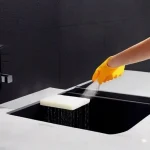The kitchen‚ often hailed as the undisputed heart of any home‚ is a vibrant hub of culinary creativity‚ lively conversations‚ and cherished family moments. Within this bustling sanctuary‚ one fixture undeniably anchors its functionality and aesthetic appeal: the kitchen sink unit. Far more than just a basin for washing dishes‚ a well-designed sink unit acts as a command center‚ dictating workflow‚ influencing storage‚ and significantly contributing to the overall ambiance of your space. For many‚ envisioning the perfect kitchen involves a bespoke touch‚ a unique element reflecting personal style and specific needs.
Imagine transforming your kitchen not merely through renovation‚ but through creation. The prospect of constructing your own kitchen sink unit‚ a seemingly daunting task‚ is actually an incredibly empowering journey. By embracing this DIY challenge‚ you unlock unparalleled opportunities for customization‚ allowing you to tailor every dimension‚ material‚ and feature to your exact specifications. This isn’t just about saving money; it’s about imbuing your home with a piece of yourself‚ crafting a functional masterpiece that stands as a testament to your vision and ingenuity. The satisfaction derived from seeing your meticulously planned design take tangible form‚ perfectly integrated into your living space‚ is immeasurable and truly rewarding‚ promising years of functional beauty.
Key Considerations for Your DIY Kitchen Sink Unit Project
| Category | Details & Insights | Reference/Example |
|---|---|---|
| Project Benefits | Unparalleled customization‚ significant cost savings compared to custom-built alternatives‚ immense personal satisfaction‚ enhanced understanding of home mechanics. | Better Homes & Gardens DIY Kitchen |
| Essential Materials | Moisture-resistant plywood (marine-grade recommended)‚ solid wood for framing‚ appropriate fasteners‚ waterproof adhesives‚ sealant‚ paint/finish‚ countertop material‚ sink basin. | Marine-grade plywood for durability. |
| Key Tools | Circular saw or table saw‚ drill/driver‚ router (optional‚ for decorative edges)‚ measuring tape‚ level‚ clamps‚ sander‚ safety gear (gloves‚ eye protection). | Kreg Jig for strong pocket-hole joinery. |
| Design Considerations | Accurate measurements (width‚ depth‚ height)‚ plumbing rough-ins‚ sink type (undermount‚ drop-in)‚ cabinet configuration (doors‚ drawers)‚ ventilation‚ aesthetic integration. | Consider ergonomic height for comfortable use. |
The Blueprint for Success: Meticulous Planning and Design
Embarking on any significant home improvement project necessitates a robust foundation of meticulous planning. For your kitchen sink unit‚ this means more than just sketching an idea; it involves detailed measurements‚ thoughtful material selection‚ and a comprehensive understanding of your existing plumbing. Seasoned carpenters often advise beginning with a precise diagram‚ accounting for every inch of available space and the exact dimensions of your chosen sink basin. Will it be a sleek undermount‚ seamlessly integrated into your countertop‚ or a traditional drop-in‚ offering a distinct edge? These choices profoundly influence the unit’s internal structure and overall aesthetic.
Selecting the right materials is paramount‚ especially given the constant exposure to moisture in a kitchen environment. While standard plywood might suffice for general cabinetry‚ investing in moisture-resistant or even marine-grade plywood for the sub-structure of your sink unit is a remarkably effective preventative measure against warping and rot. This forward-thinking choice ensures longevity and maintains structural integrity for years to come. By integrating insights from material science‚ you’re not just building a cabinet; you’re engineering a resilient fixture designed to withstand the rigors of daily use. Additionally‚ considering the placement of future plumbing lines and electrical outlets at this stage prevents costly complications down the line‚ streamlining the installation process dramatically.
From Vision to Reality: Crafting Your Unit with Precision
With your detailed plans in hand and materials carefully selected‚ the exciting phase of construction begins. Precision is your most valuable tool here‚ akin to an artist meticulously crafting a sculpture. Start by accurately cutting your chosen wood to form the foundational frame of the unit‚ employing strong joinery techniques like pocket holes or dado joints for maximum stability. Modern construction often favors pocket-hole jigs‚ which offer incredible strength and ease of use‚ even for budding DIY enthusiasts. Assembling the framework‚ you’ll witness the skeleton of your future sink unit taking shape‚ providing a tangible sense of progress and accomplishment.
Next‚ carefully attach the side panels‚ back‚ and any internal shelving‚ ensuring every surface is perfectly plumb and level. This step is critical for a professional finish and for the proper function of doors or drawers later on. Many experienced builders recommend pre-drilling pilot holes for screws to prevent wood splitting‚ a simple yet incredibly effective technique. Once the main cabinet box is assembled‚ focus on preparing the opening for your sink. This involves precise cutting‚ often with a jigsaw‚ following the manufacturer’s template for your chosen basin. The finished unit‚ standing proudly‚ is a testament to focused effort and careful execution‚ transforming raw materials into a functional and aesthetically pleasing structure.
The Final Flourish: Installation and Integration
Bringing your newly constructed unit into its destined place in the kitchen is the culmination of your efforts. Before permanently securing the unit‚ it’s imperative to address the plumbing connections. Having planned for this during the design phase simplifies the process immensely‚ ensuring adequate access for water supply lines and drain pipes. Securing the unit firmly to the wall studs provides stability and prevents any future movement‚ a crucial safety measure in a busy kitchen. Afterward‚ the countertop can be installed‚ with the sink basin meticulously sealed into its opening using a high-quality silicone caulk‚ creating a watertight barrier against potential leaks.
The final touches truly elevate your creation. Applying a durable‚ water-resistant finish‚ whether paint‚ stain‚ or varnish‚ not only protects the wood but also integrates the unit seamlessly into your kitchen’s overall design scheme. Installing cabinet doors‚ drawer fronts‚ and hardware adds both functionality and aesthetic appeal‚ reflecting your personal style. Stepping back‚ observing the transformed space‚ you’ll feel an immense pride. You haven’t just built a kitchen sink unit; you’ve engineered a vital part of your home‚ imbuing it with craftsmanship and character that off-the-shelf solutions simply cannot replicate. This project‚ while challenging‚ opens doors to a deeper connection with your living environment‚ fostering a sense of ownership and profound satisfaction that resonates throughout your home.





